You’ve inherited your grandmother’s intricate filigree brooch, but those delicate twisted wires are showing signs of age and wear. Before you consider any restoration attempts, you need to understand that one wrong move could permanently damage centuries-old craftsmanship. The difference between proper restoration and well-meaning but misguided repair work can mean the difference between preserving a treasured heirloom and accidentally destroying irreplaceable artistry that can’t be undone.
Understanding the Delicate Nature of Filigree Metalwork
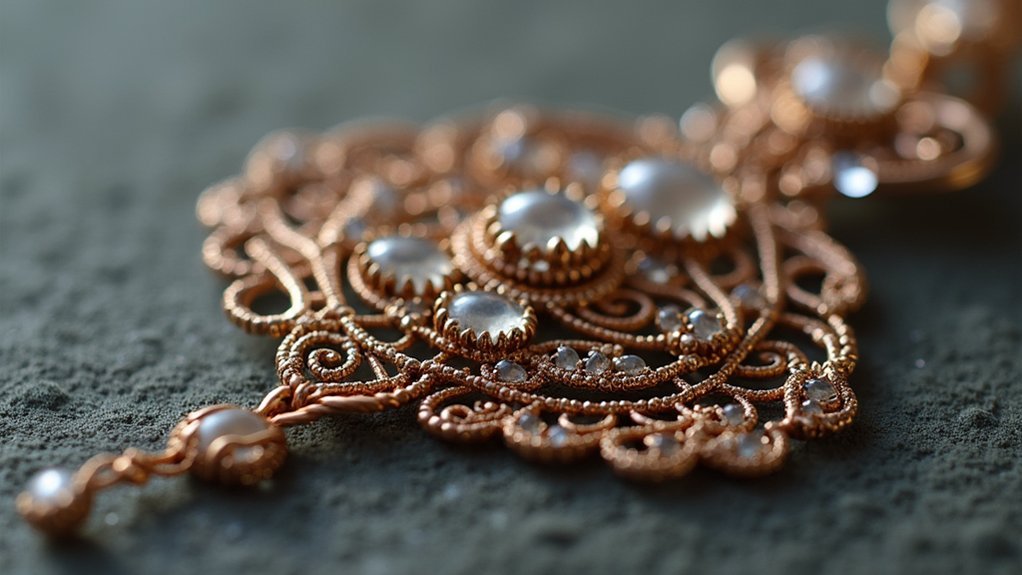
When you examine filigree jewelry closely, you’ll notice the extraordinary craftsmanship involved in creating these intricate designs from impossibly thin twisted threads of precious metals. This delicate nature means you’re handling pieces that require exceptional skill and precision to create, making them vulnerable to damage from rough handling or harsh chemicals.
You’ll find that antique filigree pieces showcase master artisan techniques, adding historical significance and value. However, this same delicacy that makes filigree so appealing also makes it susceptible to tarnishing and breakage.
Understanding these vulnerabilities helps you appreciate why proper care becomes essential. The twisted metal threads that form those beautiful patterns can easily bend or break without gentle handling and appropriate storage methods.
Preserving Historical and Cultural Significance
You’re not just repairing jewelry when you restore filigree pieces—you’re preserving ancient metalworking techniques that artisans have passed down through centuries.
Each intricate wire and soldered joint represents cultural heritage through craftsmanship, telling stories of the communities and traditions that created these masterpieces.
Your careful restoration guarantees that generational stories live on, maintaining the authentic voice of historical periods and cultural movements embedded within every delicate curve.
Ancient Metalworking Techniques Preserved
Filigree jewelry stands as a living archive of metalworking mastery that’s traveled through millennia, carrying the technical knowledge of civilizations from ancient Mesopotamia to classical Greece and traditional India. When you undertake proper jewelry restoration of antique filigree jewelry, you’re preserving techniques that master artisans developed over 5000 years ago.
| Ancient Civilization | Technique Contribution | Modern Preservation Value |
|---|---|---|
| Mesopotamia | Wire-twisting foundations | Technical knowledge base |
| Greece | Geometric pattern integration | Design methodology |
| India | Nature-inspired motifs | Cultural storytelling |
| Medieval Europe | Soldering refinements | Construction methods |
| Renaissance Italy | Miniaturization skills | Precision craftsmanship |
Each intricate filigree piece you restore maintains these endangered metalworking secrets, ensuring future craftspeople can learn from historical methods that might otherwise disappear forever.
Cultural Heritage Through Craftsmanship
Beyond preserving technical knowledge, restoring filigree jewelry protects the cultural DNA embedded within each twisted wire and soldered joint.
When you restore these delicate pieces, you’re maintaining connections to ancestral practices that span civilizations from ancient Mesopotamia to the Victorian era. Each restoration process reveals unique motifs that reflect local heritage and identity, particularly in regions like Portugal and India where traditional artistry thrives.
You’re not simply fixing jewelry – you’re preserving stories linked to significant cultural events and social traditions.
The intricate filigree patterns serve as tangible representations of historical craftsmanship, fostering appreciation for artistic techniques that’ve shaped cultural identities over centuries.
Your careful restoration guarantees this cultural heritage continues connecting present generations to their ancestral narratives and artistic expressions.
Generational Stories Live On
When you hold a restored filigree piece, you’re grasping centuries of family narratives that transform simple metal into profound storytelling vessels.
These delicate treasures carry generational stories that connect you to ancestors who celebrated life’s most precious moments wearing the same intricate craftsmanship.
Each family heirloom becomes a tangible link to personal histories spanning multiple generations.
You’re preserving:
- Wedding celebrations where brides wore filigree earrings passed down from grandmothers
- Coming-of-age ceremonies marked by gifting ancestral brooches with nature-inspired motifs
- Holiday gatherings where mothers shared stories while fastening inherited filigree necklaces on daughters
Maintaining Structural Integrity During Restoration
When you’re restoring filigree jewelry, you’ll need to focus on three critical structural elements that determine the piece’s longevity.
You must preserve the original wire framework that forms the foundation of the design, prevent damage to existing solder joints that hold components together, and reinforce any weakened metal connections without compromising the piece’s authenticity.
These structural considerations will guide every decision you make during the restoration process.
Preserving Original Wire Framework
Although filigree jewelry captivates with its intricate beauty, you’ll find that successful restoration hinges on preserving the original wire framework that defines each piece’s character.
When you’re working with these delicate pieces, maintaining every wire’s authenticity becomes vital for historical integrity.
Your restoration approach should include:
- Careful evaluation – examining each wire strand for weak points that could compromise the structure
- Systematic disassembly – cataloging every component to prevent loss of intricate design elements
- Compatible reinforcement – strengthening the framework using materials that won’t alter the vintage aesthetic
You’ll need precision techniques like laser welding to repair damaged sections without affecting the piece’s original character.
Even minor alterations can destroy the craftsmanship’s authenticity, so preserving that original wire framework isn’t optional—it’s indispensable.
Preventing Solder Joint Damage
Since solder joints form the foundation that holds your filigree’s delicate components together, protecting them during restoration becomes your most critical concern. You’ll need to examine each joint carefully to identify previous repairs and guarantee material compatibility before proceeding.
| Restoration Step | Critical Action | Why It Matters |
|---|---|---|
| Temperature Control | Use appropriate solder types and heat levels | Prevents weakening of existing joints |
| Joint Cleaning | Remove old flux and debris thoroughly | Guarantees strong, lasting bonds |
| Post-Restoration Care | Handle gently and inspect regularly | Maintains long-term integrity |
When you restore filigree jewelry, meticulous cleaning removes compromising debris while proper temperature control prevents damage to intricate designs. Your careful approach preserves the structural integrity that keeps these delicate pieces intact for generations.
Reinforcing Weakened Metal Connections
Beyond protecting existing solder joints, you’ll encounter weakened metal connections throughout your filigree piece that demand immediate reinforcement.
These vulnerable points threaten the integrity of delicate designs, requiring swift action to prevent complete failure.
Professional jewelers employ three critical techniques for reinforcing weakened metal connections:
- Re-tipping prongs – Rebuilding worn connection points where metal has worn thin or broken
- Laser soldering – Using precise heat application to strengthen joints without damaging surrounding intricate patterns
- Strategic reinforcement – Adding minimal metal support to stress points while preserving original craftsmanship
You must match the original metal type and finish during repairs to maintain structural compatibility.
Laser technology guarantees your reinforcement remains minimally invasive while providing maximum strength, preserving the visual aesthetics that make filigree jewelry so enchanting.
Professional Assessment and Evaluation Methods
When you’re dealing with valuable filigree jewelry, professional assessment becomes your first critical step toward successful restoration. Experts use specialized tools like loupes and gemological equipment to examine your piece’s structural integrity thoroughly.
They’ll evaluate the historical significance of your antique pieces, determining the most appropriate restoration approach while preserving original craftsmanship.
During professional assessment, specialists create detailed condition reports documenting damage, tarnishing, or missing components. This thorough evaluation guides your restoration process by identifying specific repair needs.
A comprehensive condition report serves as your roadmap, pinpointing exact damage and guiding targeted restoration efforts for optimal results.
Professionals carefully analyze the materials used in your filigree, ensuring any replacements match original components in size, shape, and color.
Collaborating with skilled jewelers guarantees that restoration respects your piece’s artistry, maintaining both sentimental and historical value throughout the entire process.
Gentle Cleaning Techniques for Wire Mesh Patterns
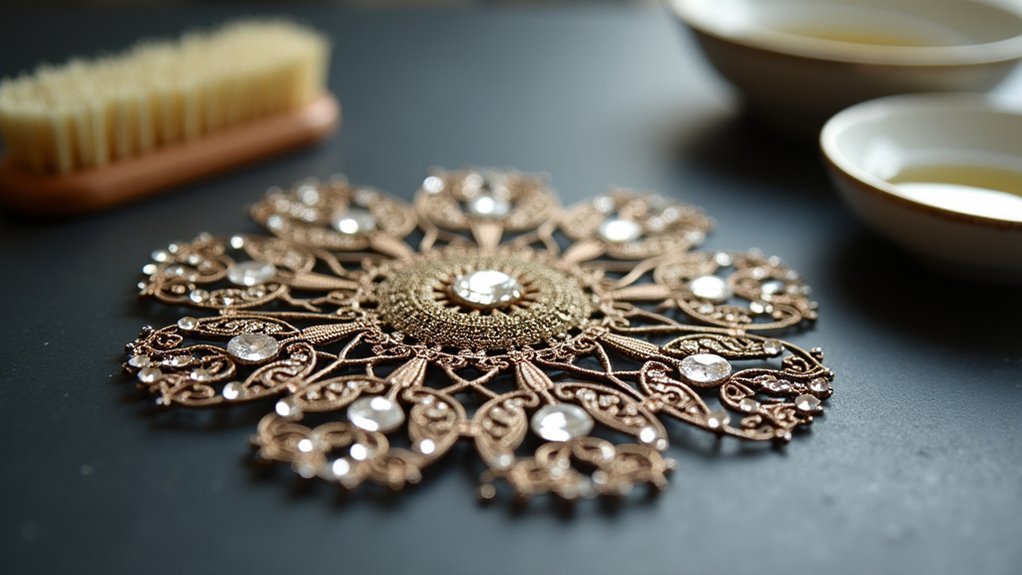
Once you’ve completed your professional assessment, you’ll need to approach the actual cleaning process with exceptional care to preserve your filigree’s delicate wire mesh patterns.
These gentle cleaning techniques will protect your precious metalwork while removing accumulated dirt and tarnish.
- Dust with precision – Use a soft brush or microfiber cloth to gently sweep away surface debris from intricate wire patterns.
- Soak strategically – Immerse your piece in warm water mixed with mild soap for several minutes to loosen stubborn grime.
- Rinse thoroughly – Carefully flush away all soap residue under lukewarm water, ensuring no cleaning solution remains trapped.
For persistent tarnish, create a baking soda paste and apply it gently.
Always dry your filigree completely before storage to prevent future deterioration.
Repairing Damaged or Missing Filigree Elements
After identifying damaged areas during your cleaning process, you’ll need to address broken or missing filigree elements with meticulous attention to detail.
Repairing damaged components requires matching the original metal’s composition, gauge, and finish to maintain your piece’s integrity. You can’t simply use any wire—each filigree piece is unique, demanding precise material sourcing and pattern replication.
Skilled artisans employ traditional soldering techniques to seamlessly integrate new components, ensuring repairs are both durable and visually cohesive.
For intricate work, professional restoration services may utilize laser welding, which allows precise, less invasive connections that preserve the delicate nature of your jewelry.
Regular inspections prevent minor issues from becoming major problems, making professional restoration essential for authentic results.
Proper Storage and Handling Practices
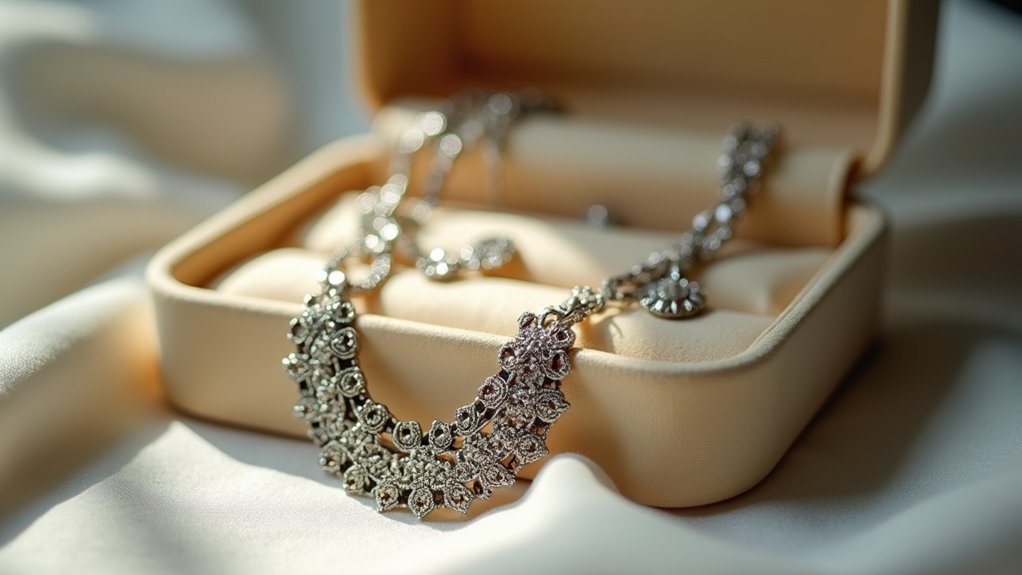
Proper storage and handling practices are essential for preserving your filigree jewelry’s intricate beauty and preventing future damage.
You’ll need to implement safe storage solutions that protect these delicate pieces from scratches, tangling, and environmental factors that cause deterioration.
Additionally, you must master gentle handling techniques that minimize stress on the fragile metalwork while keeping oils and contaminants away from your precious pieces.
Safe Storage Solutions
Preservation of filigree jewelry’s intricate beauty begins with thoughtful storage choices. Safe storage solutions protect delicate pieces from damage that can compromise their artistic value.
You’ll want to invest in proper storage systems that prevent scratching while maintaining the jewelry’s structural integrity.
Consider these essential storage components:
- Individual padded compartments – Separate each piece to avoid tangling and surface damage
- Soft fabric pouches – Wrap delicate items in breathable materials that repel dust and moisture
- Clean, chemical-free environment – Store in areas free from harsh substances that cause tarnishing
Never stack heavy items on your filigree pieces, as their delicate construction makes them vulnerable to deformation.
Regular inspections help you catch potential issues early, ensuring your jewelry maintains its intricate beauty for generations.
Gentle Handling Techniques
Three fundamental principles guide successful filigree handling: cleanliness, gentleness, and awareness.
Always wash and dry your hands thoroughly before touching any piece, as skin oils and moisture cause tarnishing and deterioration. These delicate pieces require special care during every interaction – support them from underneath rather than gripping thin wires or decorative elements that could bend or break.
When moving filigree jewelry, handle one piece at a time with deliberate, slow movements. Avoid rushing or multitasking, as distraction leads to accidents.
Never pull on chains, pendants, or dangling components. Instead, lift pieces by their sturdiest sections, typically the main body or mounting areas.
Proper jewelry care means recognizing when pieces need professional attention rather than attempting repairs yourself, preserving their intricate artistry for years.
Tools and Equipment for Filigree Restoration
Several specialized tools form the foundation of successful filigree restoration work.
Professional filigree restoration demands precision instruments and specialized techniques to preserve the delicate artistry of these intricate metalwork masterpieces.
You’ll need fine-tipped pliers and various files to handle delicate metalwork without causing damage. A microscope or magnifying loupe becomes essential for examining intricate details and detecting minute flaws that require attention.
Your restoration toolkit should include:
- Ultrasonic cleaners that use high-frequency sound waves to gently remove dirt and tarnish from fragile structures
- Specialized soldering materials like gold or silver solder to maintain authenticity while ensuring durable repairs
- Protective gear including gloves and eye protection to safeguard both you and the jewelry during detailed work
These tools enable precise restoration of delicate filigree pieces while preserving their original craftsmanship and historical value.
Matching Original Materials and Techniques
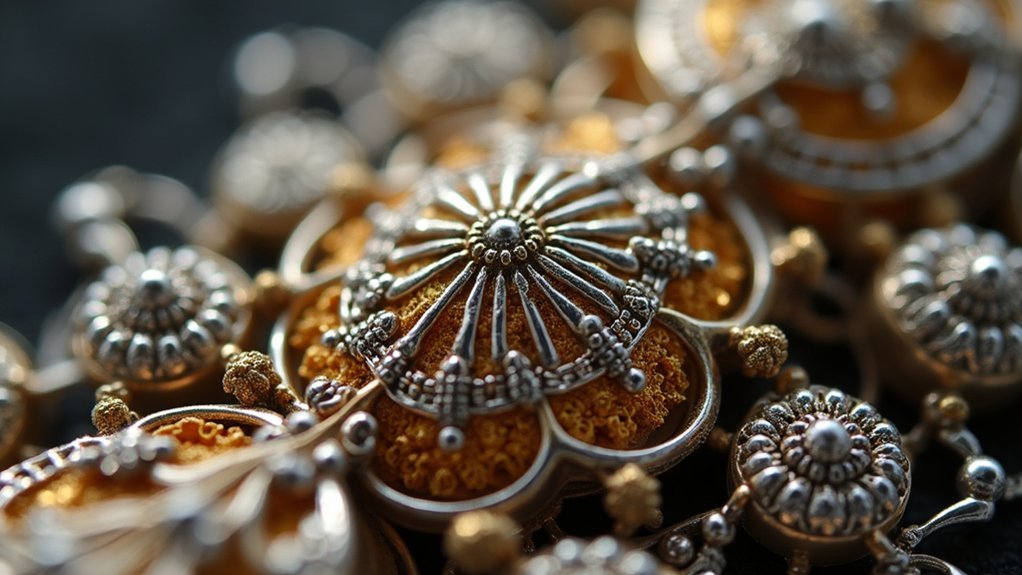
Four fundamental principles guide authentic filigree restoration, with material matching serving as the cornerstone of preserving historical integrity.
You’ll need to identify the specific type of gold or silver used in the original piece, then source identical metals to maintain authenticity.
When applying authentic filigree techniques, you must twist fine metal threads using the same methods craftsmen employed centuries ago. This guarantees your restoration preserves the piece’s historical charm and craftsmanship.
You can’t overlook period-appropriate gemstones and components, as modern alternatives diminish historical value.
Traditional restoration techniques like hand soldering and careful polishing are essential for maintaining delicate details.
Preventing Further Deterioration and Damage
While matching original materials forms the foundation of restoration, protecting your filigree jewelry from future damage requires equally careful attention to preservation techniques.
Proper restoration techniques help preserve intricate designs by shielding delicate filigree from moisture, chemicals, and physical stress that accelerate deterioration.
You’ll want to implement these essential protective measures:
- Schedule regular professional inspections to catch loose components and early tarnishing before they worsen.
- Avoid abrasive cleaning methods that can compromise the structural integrity of wire work.
- Store pieces in controlled environments away from humidity and harsh chemicals.
Restoring Oxidation and Surface Treatments
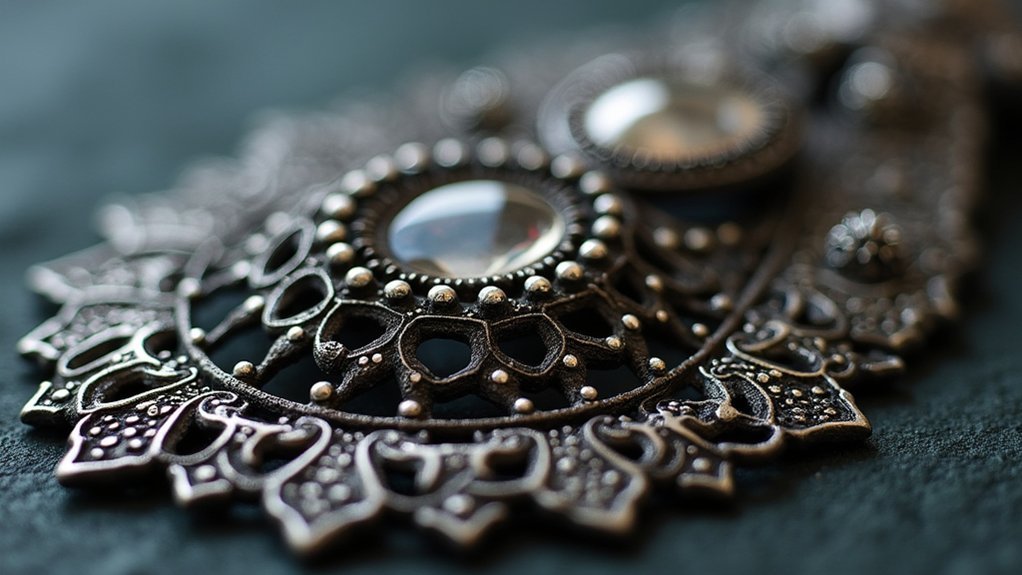
Oxidation presents one of the most common yet treacherous challenges in filigree restoration, as the very cleaning methods that effectively remove tarnish can easily destroy the delicate wirework you’re trying to preserve. When restoring oxidation on delicate filigree, you’ll need specialized techniques that prioritize gentleness over speed.
| Method | Risk Level | Effectiveness | Best For |
|---|---|---|---|
| Mild soap + soft brush | Low | Moderate | Regular maintenance |
| Ultrasonic cleaning | Very low | High | Professional restoration |
| Light polishing | Medium | High | Surface enhancement |
| Chemical cleaners | High | Variable | Avoid completely |
Professional restorers typically use ultrasonic baths for thorough yet gentle cleaning, ensuring tarnish removal without harming intricate details. Surface treatments like light polishing can enhance luster while preserving structural integrity, maintaining both appearance and historical value.
Documentation and Authentication Processes
Beyond the physical restoration work lies an equally important responsibility: creating detailed records that preserve your filigree piece’s story and verify its authenticity. Proper documentation guarantees you’ll maintain your jewelry’s integrity and historical value throughout the restoration process.
You’ll need to establish extensive records through these essential steps:
- Capture detailed photographs showing your piece’s condition before any work begins, documenting every intricate wire pattern and surface detail.
- Record all restoration materials and techniques used during the process, creating a permanent history of interventions.
- Obtain professional authentication through expert evaluation and gemological analysis specific to your piece’s origin period.
Working with specialized filigree restorers guarantees adherence to proper documentation standards. They’ll help you create valuable records for insurance purposes while safeguarding your jewelry’s heritage and market value.
Long-term Preservation and Maintenance Strategies
Once you’ve completed your filigree restoration, implementing a proper maintenance routine becomes crucial for protecting your investment and preserving the piece’s delicate beauty. You’ll need regular inspections using gentle cleaning methods with soft brushes and mild soap to maintain the intricate patterns without causing damage.
| Care Practice | Why It Matters |
|---|---|
| Padded storage compartments | Prevents scratches on delicate wirework |
| Avoid harsh chemicals | Protects against tarnishing and corrosion |
| Professional consultations | Guarantees restoration-appropriate maintenance |
You should store your filigree in soft fabric bags and remove jewelry before applying lotions or perfumes. Consulting with specialized restorers provides tailored strategies that respect the craftsmanship’s heritage while guaranteeing your intricate piece remains stunning for future generations.
Frequently Asked Questions
How to Clean Delicate Silver Filigree?
You’ll gently brush away dust, soak in warm soapy water, rinse thoroughly, and dry with a lint-free cloth. Don’t use harsh chemicals that’ll damage the intricate metalwork.
What Is the Significance of Filigree?
You’ll appreciate filigree’s 5,000-year legacy from ancient Mesopotamia, where artisans created intricate wire designs. It’s evolved through Victorian sentimentality and Art Deco geometry, preserving cultural traditions while inspiring today’s contemporary jewelry aesthetics.
Which of the Following Is an Essential Step in the Filigree Workmanship?
You’ll find that meticulously twisting thin metal wires creates intricate patterns as the most essential step in filigree workmanship. This process demands extraordinary skill and precision to achieve the delicate, complex designs characteristic of this craft.
Why Is Filigree so Expensive?
You’ll pay premium prices for filigree because it’s labor-intensive handcraft requiring skilled artisans, precious metals, and specialized techniques. The declining number of master craftspeople makes authentic pieces increasingly rare and valuable.
In Summary
You’ll find that properly restoring your delicate filigree jewelry isn’t just about fixing what’s broken—you’re preserving generations of artistry and cultural heritage. When you invest in professional restoration, you’re ensuring these intricate pieces maintain their structural integrity and authentic beauty. Don’t risk amateur repairs that could damage irreplaceable craftsmanship. By following proper techniques and long-term maintenance strategies, you’ll protect your jewelry’s value while honoring its historical significance for future generations.

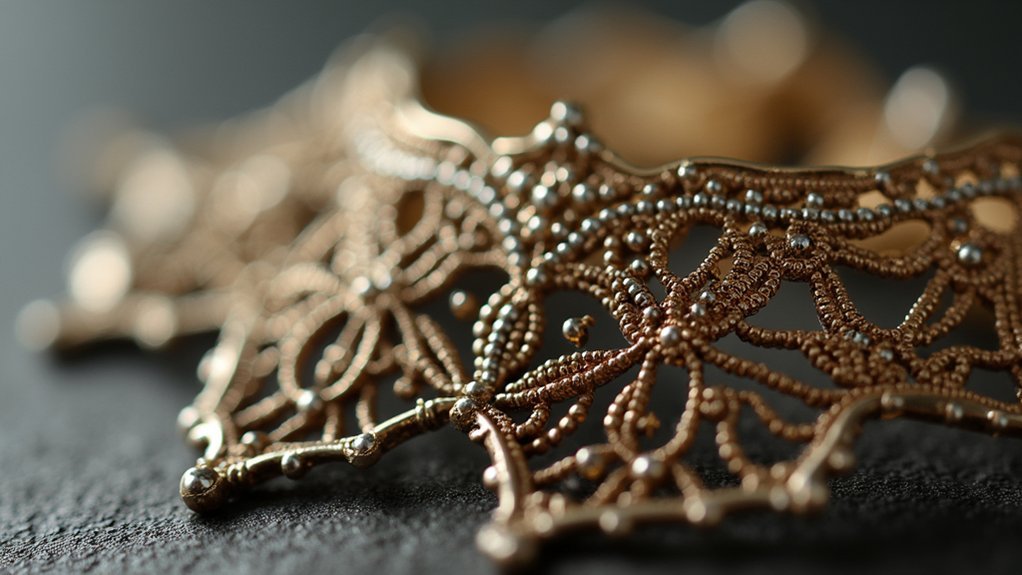
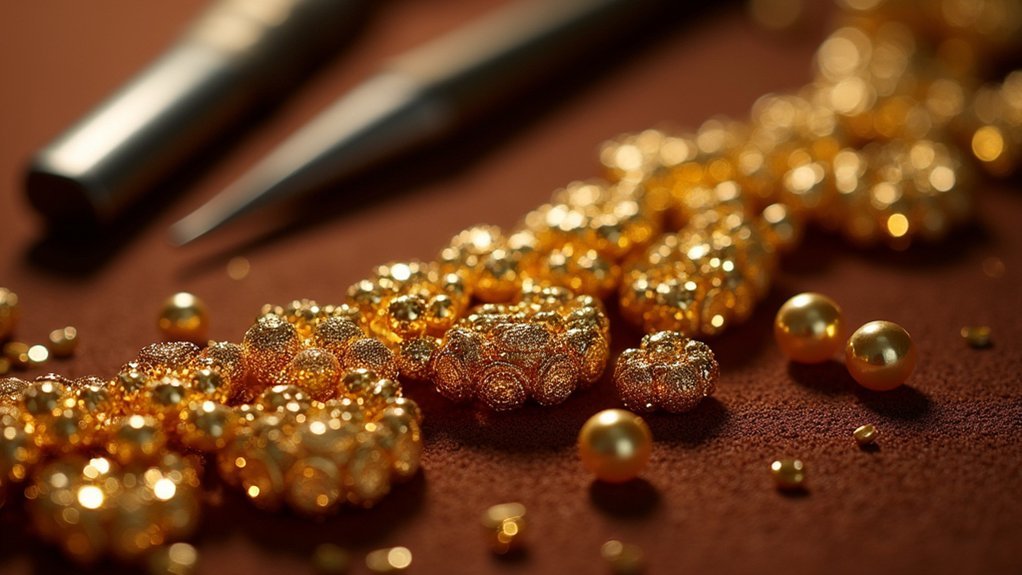
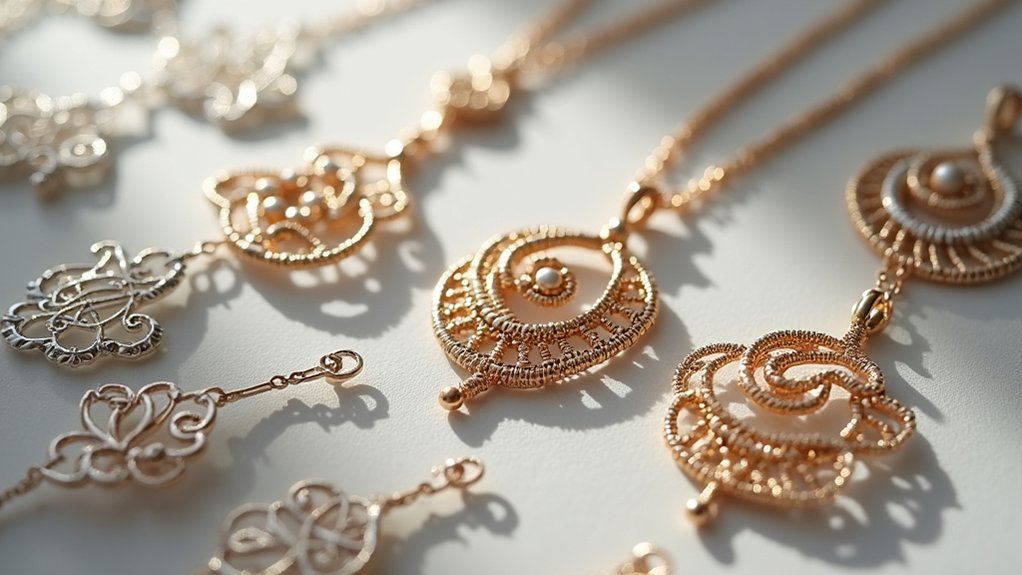
Leave a Reply